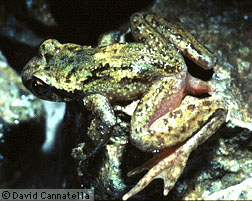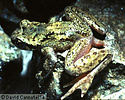Ascaphus
Tailed Frogs
David CannatellaIntroduction
The tailed frogs get their name from the copulatory organ of the male, which resembles a short tail, but is really an expanded portion of the cloaca. These species are among the very few frogs with internal fertilization; the copulatory organ is used to transfer sperm to the female. They inhabit cold streams in humid forests and the areas around them. The two species of Ascaphus range from British Columbia south to Mendocino County, California, the Rocky Mountains of Idaho and Montana, and adjacent Washington and Oregon. Ascaphus is not known to have an advertisement call, and thus many aspects of their reproductive behavior are poorly known because they cannot be easily observed. The frogs are semi-aquatic and most active in the vicinity of streams at night.
The tadpole has a large suckerlike mouth that occupies about one-half of the ventral surface of the body. It also has a large number of denticles (2-3 upper and 7-12 lower rows). Tadpoles of most species of frogs have only two upper and three lower rows of denticles. Ascaphus uses its sucker to adhere to and move among rocks in cold, swift streams. The function of the suction mechanism was studied by Gradwell (1971).
Discussion of Phylogenetic Relationships
Currently, two species are recognized, a coastal species A. truei, and an inland, montane species, A. montanus. Previously, these were recognized as subspecies, along with a third subspecies, Ascaphus californicus. Nielson et al. (2001) studied the phylogeography and concluded that two species should be recognized; see also Carstens et al. (2005).
Much previous literature on both species of Ascaphus is subsumed under the name Ascaphus truei. Because the species are allopatric, assignment to the correct species can usually be done if the locality of origin is known.
Relationships to Outgroups
In the past, Ascaphus and Leiopelma generally were placed in the same family, sometimes called Ascaphidae or Leiopelmatidae (the latter name is the correct one). This arrangement has been recognized as one based on sharing primitive characters (Green and Cannatella, 1993), because no morphological synapomorphies have been proposed to unite the two taxa.
However, analyses of molecular data have indicated that Ascaphus and Leiopelma are sister-groups, but very deeply diverged. Hay et al. (1995) analyzed relationships among families of frogs using 12S and 16S rRNA and found Ascaphus and Leiopelma to be sister-groups. The same arrangement was found by Roelants et al. (2005) and San Mauro et al. (2005).
Most current classifications include Ascaphus in the family Ascaphidae, which along with the Leiopelmatidae retains nine vertebrae in front of the sacrum, and "tailwagging" muscles, both primitive features among living frogs. Because the only taxon in Ascaphidae is Ascaphus, the family name Ascaphidae is taxonomically redundant, but many systematists use Ascaphidae to have a consistent listing of taxa at the family rank.
Geographic Distribution


The distribution of living Ascaphus is indicated in red. Representatives of this genus are found in North America from British Columbia south to Mendocino County, California, the Rocky Mountains of Idaho and Montana, and adjacent Washington and Oregon.
References
Carstens, B. C., S. J. Brunsfeld, J. R. Demboski, J. M. Good, and J. Sullivan. 2005. Investigating the evolutionary history of the Pacific Northwest mesic forest ecosystem: hypothesis testing within a comparative phylogeographic framework. Evolution 59(8):1639-1652.
de Villiers, C. G. S. 1934. Studies on the cranial anatomy of Ascaphus truei Stejneger, the American "leiopelmid". Bull. Mus. Comp. Zool. 77:1-38.
Ford, L. S., and D. C. Cannatella. 1993. The major clades of frogs. Herp. Monogr. 7:94-117.
Gradwell, N. 1971. Ascaphus tadpole: experiments on the suction and gill irrigation mechanisms. Can. J. Zool. 49(3):307-332.
Green, D. M., and D. C. Cannatella. 1993. Phylogenetic significance of the amphicoelous frogs, Ascaphidae and Leiopelmatidae. Ecol. Ethol. Evol. 5:233-245.
Green, D. M., T. F. Sharbel, R. A. Hitchmough, and C. H. Daugherty. 1989. Genetic variation on the genus Leiopelma and relationships to other primitive frogs. Z. zool. Syst. Evolut.-forsch. 27:65-79.
Hay, J. M., I. Ruvinsky, S. B. Hedges, and L. R. Maxson. 1995. Phylogenetic relationships of amphibian families inferred from DNA sequences of mitochondrial 12S and 16S ribosomal RNA genes. Mol. Biol. Evol. 12(5):928-937.
Metter, D. 1967. Variation in the Ribbed Frog Ascaphus truei Stejneger. Copeia 1967(3):634-649.
Metter, D. E. 1964. A morphological and ecological comparison of two populations of the tailed frog, Ascaphus truei Stejneger. Copeia 1964:181-195.
Metter, D. E. 1968. Ascaphus, A. truei. Cat. Amer. Amphib. Rept. 69(1-2).
Nielson, M., K. Lohman, and J. Sullivan. 2001. Phylogeography of the Tailed Frog (Ascaphus truei): implications for the biogeography of the Pacific Northwest. Evolution 55(1):147-160.
Nishikawa, K. C., and D. C. Cannatella. 1991. Kinematics of prey capture in the Tailed Frog, Ascaphus truei (Anura: Ascaphidae). Zool. J. Linn. Soc. 103(3):289-307.
Reiss, J. O. 1997. Early development of chondrocranium in the tailed frog Ascaphus truei (Amphibia: Anura): Implications for anuran palatoquadrate homologies. J. Morph. 231:63-100.
Ritland, R. M. 1955. Studies on the post-cranial morphology of Ascaphus truei. I. Skeleton and spinal nerves. J. Morphol. 97:119-177.
Ritland, R. M. 1955. Studies on the post-cranial morphology of Ascaphus truei. II. myology. J. Morph. 97:215--282.
Roelants, K., and F. Bossuyt. 2005. Archaeobatrachian paraphyly and Pangaean diversification of crown-group frogs. Syst. Biol. 54(1):111-126.
San Mauro, D., M. Vences, M. Alcobendas, R. Zardoya, and A. Meyer. 2005. Initial diversification of living amphibians predated the breakup of Pangaea. American Naturalist 165(5):590-599.
Stejneger, L. 1899. Description of a new genus and species of discoglossoid toad from North America. Proc. U. S. Natl. Mus. 21(1178):899-902.
van Dijk, D. E. 1955. The "tail" of Ascaphus: a historical resume and new histological-anatomical details. Ann. Univ. Stellenbosch 31(1):1-71.
Van Eeden, J. A. 1951. The development of the chondrocranium of Ascaphus truei Stejneger with special reference to the relations of the palatoquadrate to the neurocranium. Acta Zool., Stockholm 32:41-176.
Information on the Internet
- Ascaphus truei, Tailed Frog. DigiMorph.
Title Illustrations

| Scientific Name | Ascaphus truei |
|---|---|
| Location | Oregon |
| Specimen Condition | Live Specimen |
| Sex | Male |
| Image Use |
 This media file is licensed under the Creative Commons Attribution-ShareAlike License - Version 3.0. This media file is licensed under the Creative Commons Attribution-ShareAlike License - Version 3.0.
|
| Copyright |
© 1995 David Cannatella

|
About This Page
If you are interested in authoring or co-authoring the page for this taxon, or some part of it (even a species), contact David Cannatella.
David Cannatella

University of Texas, Austin, Texas, USA
Correspondence regarding this page should be directed to David Cannatella at
Page copyright © 1995 David Cannatella
 Page: Tree of Life
Ascaphus. Tailed Frogs.
Authored by
David Cannatella.
The TEXT of this page is licensed under the
Creative Commons Attribution License - Version 3.0. Note that images and other media
featured on this page are each governed by their own license, and they may or may not be available
for reuse. Click on an image or a media link to access the media data window, which provides the
relevant licensing information. For the general terms and conditions of ToL material reuse and
redistribution, please see the Tree of Life Copyright
Policies.
Page: Tree of Life
Ascaphus. Tailed Frogs.
Authored by
David Cannatella.
The TEXT of this page is licensed under the
Creative Commons Attribution License - Version 3.0. Note that images and other media
featured on this page are each governed by their own license, and they may or may not be available
for reuse. Click on an image or a media link to access the media data window, which provides the
relevant licensing information. For the general terms and conditions of ToL material reuse and
redistribution, please see the Tree of Life Copyright
Policies.
- Content changed 01 December 2008
Citing this page:
Cannatella, David. 2008. Ascaphus. Tailed Frogs. Version 01 December 2008 (under construction). http://tolweb.org/Ascaphus/16966/2008.12.01 in The Tree of Life Web Project, http://tolweb.org/








 Go to quick links
Go to quick search
Go to navigation for this section of the ToL site
Go to detailed links for the ToL site
Go to quick links
Go to quick search
Go to navigation for this section of the ToL site
Go to detailed links for the ToL site